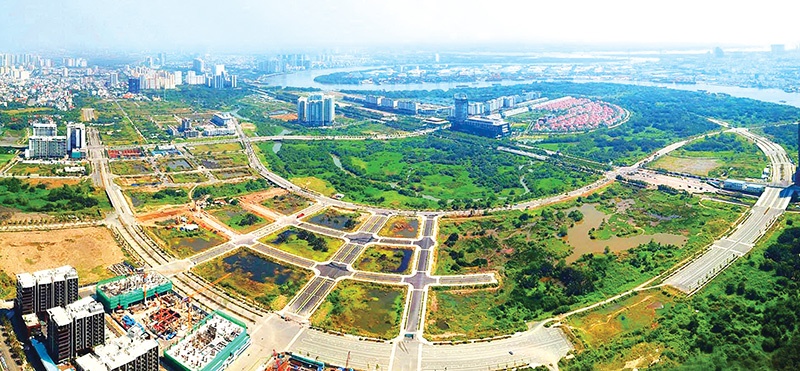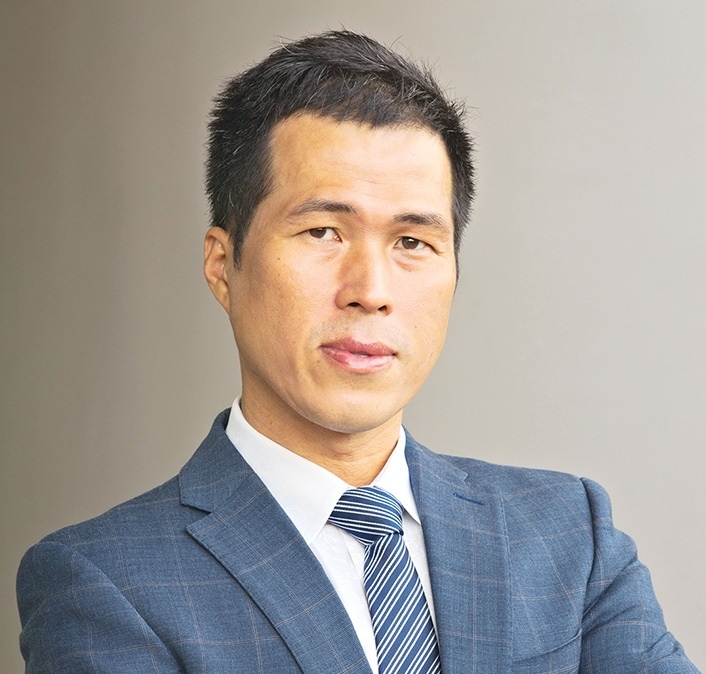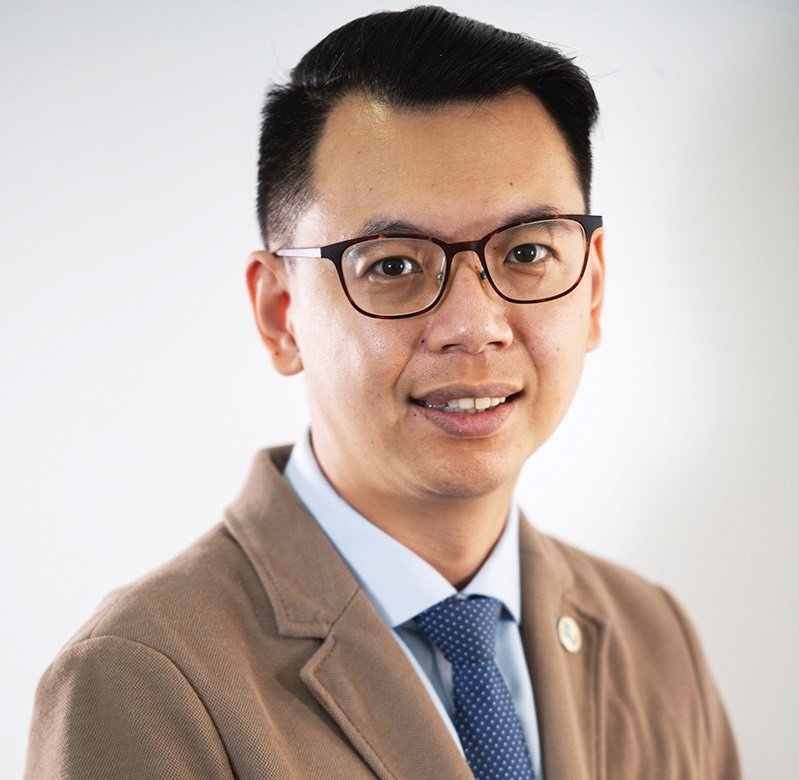Visualising a new global finance hub
 |
| Ho Chi Minh City already has the foundation to become an international financial centre, photo Le Toan |
Building Ho Chi Minh City into a regional and international financial centre has been an ambitious idea for many years, supported by many domestic and international economic experts.
Chairman of Ho Chi Minh City People’s Committee Phan Van Mai said that the central government has agreed to include in the 13th Party Congress a resolution to build Ho Chi Minh City into an international financial centre.
“This is an important policy to help the city implement its aims. In 2021, the city has carried out preparations such as establishing a steering committee, a working group to develop a project, and inviting a consulting unit to initially study the model and mechanism of financial markets,” Mai said.
“However, the pandemic has slowed down the process and now is the right time to accelerate research, complete the project, and submit it to the competent authorities to develop the financial centre project,” he added.
Chairman of Ho Chi Minh City Finance and Investment State-owned Company (HFIC) Nguyen Ngoc Hoa said that the city has a new approach in two dimensions.
The first is from the policymakers to see what needs to be done to build such a centre. With this approach, the city has assigned HFIC to work with Fulbright University to jointly define the foundation, principles, composition and necessity of building an international financial centre. The second dimension is from the demand approach, where investors can express their expectations on the mechanism and policies of the centre, Hoa said.
“We combine both the needs of this centre with the wishes of investors to come up with the best proposal,” Hoa said.
He added that in this project, Ho Chi Minh City clearly defines the goal of becoming a hub to attract corporate, private, and global capital flows. However, the most important factor is how to spend it effectively.
The city has assigned HFIC to collect expert opinions to summarise and submit to the government and report to the Party and state leaders.
| An MoU was signed on February 8 between Ho Chi Minh City People’s Committee and Import-Export Pan Pacific Group on researching and preparing a project to build an international financial centre in the southern region. According to the MoU, the group will sponsor the study plan of establishing the centre in Ho Chi Minh City, connecting with foreign investors and funds as well as hiring American enterprises to provide consultancy on the plan completion. It guarantees to hand over the plan to Ho Chi Minh City within 60 days. |
According to Johnathan Hanh Nguyen, chairman of Import-Export Pan Pacific Group, foreign investors are very interested in building a financial centre in Ho Chi Minh City.
Notably, US investors have committed to immediately pour $10 billion when the competent authority approves the construction of the financial centre. Around $4 billion of this is expected to be used for a similar venture in Danang and the rest for Ho Chi Minh City.
According to Nguyen, before the shift of financial institutions in the region and the world, Southeast Asian countries are fiercely racing to invite investors. For Vietnam to seize this opportunity, domestic policy needs a breakthrough and more incentives than the current legal framework for establishing financial centres.
At a February 17 seminar on creating a breakthrough for economic development in Ho Chi Minh City and beyond, Vo Tri Thanh, director of the Institute for Branding and Competition Strategy, outlined the key points to building an international financial centre.
Thanh said it is necessary to have an outstanding breakthrough institution with high international competitiveness that is fresh and not outdated. Chosen investors must be high-qualified in different aspects, not only in their finance. The project must also be established in combination with overseas and domestic aspects, with thoughts on world finance, economy, and currency but attached to a strict domestic legal framework.
Meanwhile, economist Can Van Luc stressed the necessity of imagining what this centre will be like first, saying whether it could be a high-rise building like Bitexco Financial Tower or a Wall Street of New York, or could it be combined with entertainment facilities such as casinos and tourism complexes.
Apart from that, Luc added that the financial world is changing very quickly as digital transactions and cryptocurrencies will be a more dominant monetary trend moving forward.
“Vietnam should itself decide its position in such a changing world to have a trendy financial centre that keeps up with world trends,” Luc said.
| Truong Bui - Partner and head Roland Berger Vietnam
An appropriate model for Ho Chi Minh City should take full advantage of the city’s strategic location and match the future demand of ever-evolving international financial centres. This challenge will have to be determined through its strategic direction. Roland Berger has drawn many lessons in advising development models for leading cities worldwide. Based on this experience, for Ho Chi Minh City to become a regional or international financial centre, a combination of hard and soft layers is vital. Hard layers refer to advanced IT systems, capital market exchanges, the presence of multinational financial services companies and well-established connectivity infrastructure. Ho Chi Minh City also needs to build up soft layers such as a world-class living environment to attract high-quality talents, an open and friendly business ecosystem to attract startups, especially in fintech – and an international education system to build the local human resource foundation and create appeal for global experts who might consider Ho Chi Minh City to live and work in due to the world-class education available for their children. We believe that Ho Chi Minh City can pursue an innovative, integrated financial centre model, but it must support the key industries it serves in Vietnam. In addition, it should be designed based on a holistic ecosystem approach that anchors the financial centre and drives advancements in knowledge, technology, and innovation. | |
| Seng Kiong Kok - Finance lecturer RMIT University
Ho Chi Minh City is in an opportune moment in that it does not have to abide by a single model for financial centre creation, but rather is able to adapt from the best of them to ensure its robust development within this arena moving forward. Characteristically, the city possesses numerous qualities that have shown to be antecedents of successful financial centre creation, such as a deep and flexible labour market with increasing intellectual capital and the growing internationalisation of its non-financial sectors. There is also a substantial embrace of economic digitalisation, with Ho Chi Minh City being a regional pioneer for the development of emerging technologies such as blockchain within the fintech ecosystem, thus furthering its reputation as being on the frontiers of Industry 4.0 integration. As part of RMIT’s FinTech-Crypto Hub, within the university’s School of Business and Management, I have experienced this first hand with our interface with the local fintech and blockchain sector, and also from the excitement and intrigue that is evinced amongst our students about these new technologies. It would serve Ho Chi Minh City’s ambitions well to augment its financial centre development with consideration for the interest shown in these emergent technologies, whilst at the same time, strengthening its rule of law and also contract enforcement to accommodate not only regional but also international development and assimilation. | |
| Tan Eng Kiat - Senior urban planning and design manager Surbana Jurong
Vietnam has a vibrant startup economy and the space demand for startups and the tech sector are more varied as compared to the needs of the traditional financial sector. A hybrid model would be more suitable to cater to the changing needs of Vietnam’s economy. There is less of a dependence on large footprint offices, as regional headquarters will still base themselves in their current locations unless there is a significant shift in the tax regime, be it in Vietnam or their country of operations. Instead, having smaller spaces that can be amalgamated into a larger contiguous space allows for the flexibility required in the tech and startup space. Beyond this, it is also good practice to provide for a good variety of spaces, rather than be restricted to the relatively homogeneous needs of banking corporations. This variety fosters a more vibrant real estate space, consequently positively impacting the diversity in the working and resident population. There is also a need to focus on the liveability aspect, an important focus to foster a strong innovation culture and make it attractive not only to startups and tech companies but creating a better city to live in. Commercial buildings in financial centres are often favoured over recreation spaces as they bring a greater return on investment. This puts the central business districts at risk of becoming deserted after work hours. Ho Chi Minh City has potential to avoid this as the current city fabric is very fine-grained, with a strong culture of social activities. |
What the stars mean:
★ Poor ★ ★ Promising ★★★ Good ★★★★ Very good ★★★★★ Exceptional
Related Contents
Latest News
More News
- Sun Group breaks ground on $2 billion Van Don casino complex (December 19, 2025 | 18:14)
- Rare, beautiful, sustainable: the mark of iconic real estate (December 19, 2025 | 08:00)
- Owner-occupied housing stabilises, paving the way for new growth cycle (December 18, 2025 | 17:04)
- Unlocking urban potential of smart cities (December 18, 2025 | 16:50)
- Green finance offers 'passport' for Vietnamese construction, building materials firms (December 15, 2025 | 08:00)
- Gamuda Land commit long-term investment (December 12, 2025 | 11:49)
- HITC ties up with Evolution to develop AI and hyperscale data centres in Vietnam (December 11, 2025 | 12:09)
- Real estate deals boom via high-profile names (December 08, 2025 | 11:32)
- Industrial segment shaped by M&As (December 08, 2025 | 08:00)
- The Privé sets the benchmark for luxury real estate (December 05, 2025 | 08:28)




 Tag:
Tag:





















 Mobile Version
Mobile Version